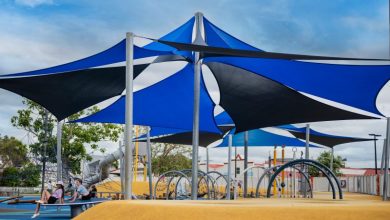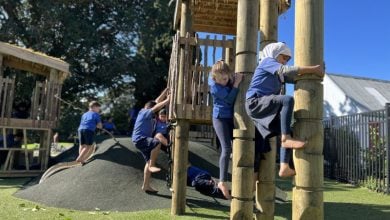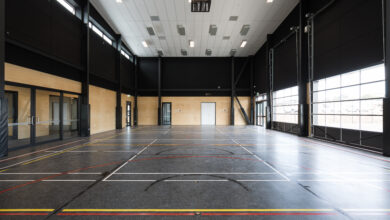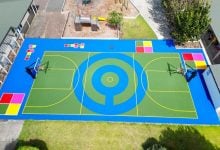Case Study Carisbrook School | Three-school merger brings new era
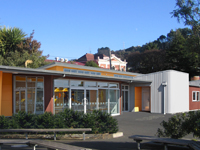
 School mergers are never easy, especially when it entails trying to seamlessly fuse more than two schools into one.
School mergers are never easy, especially when it entails trying to seamlessly fuse more than two schools into one.
In the case of the new Carisbrook School in the Caversham district of Dunedin, the challenge involves three schools, but when the task is completed, the outcome should be well worth while for both the pupils and the community.
The schools involved were all fairly small – the former Caversham, College Street and Calton Hill primary schools. In their new guise they have become Carisbrook School, but at this stage are still operating on their original three sites, which in the meantime are being termed: the main site, the Terraces site and the Heights site. But with building work scheduled to start in the latter part of this year, in 2014 they will morph in to one, located at the original Caversham School.
The merger was initiated by the Ministry of Education last year to make more cost effective use of the schools – two that each had a roll of about 150 pupils and one of about 75. One school was of the elderly wooden Nelson block design, one an older wooden single level construction, and one slightly younger, of brick. All had the familiar deficiencies of schools of that vintage – traditional square box construction, including immovable walls, shortcomings in temperature and sound control, plus being totally unsuitable for modern ICT learning.
Understandably, when the Ministry’s decision was announced, there were concerns among teaching staff and parents of pupils at each of the three schools and an expectation that the principal of the new Carisbrook School would be one of the three incumbents. However, the task of guiding the amalgamation and performance of the new Carisbrook for the foreseeable future instead went to someone new to the area – Ben Sincock, the then principal of Brockville School.
Since he took on his new position in January, he has found himself spread thinly, trying to maintain high standards across three sites while helping to plan the development of the new one. He has found there are considerable challenges.
“There’s no question about the quality of teaching and learning for the pupils who still have the majority of their original teachers – it’s just the logistics of managing a school spread over three sites. Along with some of our specialist teachers I have to rotate around the sites, which isn’t ideal, but considering everything it’s coming together nicely.”
With regard to the new campus, the challenge is helped greatly by the fact that the Ministry had appointed Opus Architecture as the design consultant and project manager. Opus Architecture has considerable experience in bringing older schools into the modern era and Ben Sincock is happy with progress so far.
“We’ve been working really well with Opus and the Ministry with regard to getting the project underway. There’s been a lot of consultation with staff about what our needs are for creating modern learning environments.
“We’ve been very impressed with Opus. They consult and meet with us regularly. They listen to what we’re after and work around it to create options. The positive aspect of the merger is that we’re going to end up with modern learning environments – with classroom spaces that are set up to cater for pupils in the 21st Century.
“With the old schools, there wasn’t the opportunity for variable teaching spaces to meet different needs. Some of our pupils work better in smaller, less noisy environments, while some prefer to work out in the light open spaces. Others prefer the learning cave scenario.
The new Carisbrook School will have lots of breakout spaces, both indoor and outdoor, giving pupils the opportunities to work in a variety of environments. That can include the classroom furniture and equipment. These days, instead of everyone having the same seating arrangements, you aim to meet a variety of learning needs. For example, we have several pupils who prefer to stand for some activities. They’ll be able to work in a way that suits them within the classroom.
“With variable learning spaces, there’s also the opportunity to join classes together to make larger groups, creating opportunities for team teaching. It also makes for a better flow from one learning space to another.
“We also had to take into consideration the size of our school grounds. We didn’t want to greatly increase our footprint on the land – we wanted to ensure that we still had sufficient open spaces for recreational activities, so we’ve had to be creative on how the new building will fit onto the site.”
A new boiler system will be needed to cater for 450 the combined roll of pupils while double glazing and insulation will make a big difference to maintaining comfortable temperature control throughout the year.
A big plus with the development will be in regard to ICT with the latest technology available. “Basically, all our classes will have interactive whiteboards installed and students able to access a wide range of ICT equipment,” Ben said.
The first step forward will be the refurbishment of the first four-classroom Nelson block for all the year seven and eight pupils from the three sites, which will be open in time for the beginning of the first term next year. Stage one also involves the construction of a new six space junior block which will be ready by the first day of Term Two.
Stage two involves the refurbishment of the remaining two Nelson blocks and the construction of a new four teaching space block that will link the two Nelson blocks. In all, there will be 10 new teaching spaces. It is intended that all staff and pupils will be ensconced in their new buildings on the main site at the beginning of 2014, with stage two construction overlapping stage one.
Another plus of the development and its up-to date facilities will be to allow the school to involve the Caversham community much more. “We intend to be a community based school and offer educational opportunities and experiences to the wider community after hours,” Ben said.
“It’s very exciting to think that within the next 18 months we’re going to have a basically brand new school. Not many schools ever have that opportunity, so the pupils and most of the community are really thrilled about it.”
By Brent Leslie


